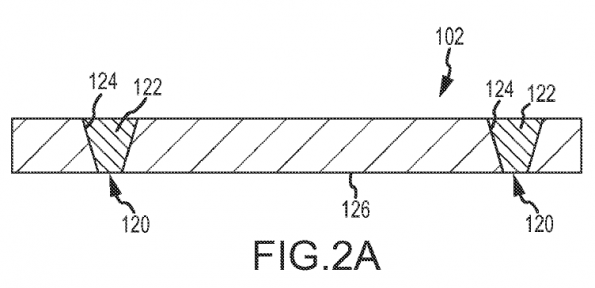sapphire – the gem stone in apple’s eye
Yesterday saw coverage of another published Apple patent application. In this case it was US2014/0023430 i.e. “Attachment Techniques”.
The ‘430 application, as I will call it, is a rather short eleven pages. It presents, as it appears in hindsight, a rather simple method and structure of attaching sapphire to another structure. Much of the early coverage from the usual Apple blogs was, on a high level, not too bad. There was some fraying at the edges of the story towards the end of the day, but that is to be expected. In summary, the ‘430 is in fact an application at this point with no issued claims. Will we see a sapphire display in the iPhone 6? I do not know, but I do know the “430 application will not tell us one way or the other. So what can the ‘430 application tell us?
The ‘430 application presents attachment techniques for sapphire. As an example let’s consider Figure 2A of the application. It is reproduced below. Here a cross-section 102 through a sapphire cover is presented. Apertures 120, may have tapered sidewalls 124 and are to be filled with second material 122. This second material 122 then becomes the coupling point for the sapphire cover. OK … that seems pretty straightforward.

There is though for sure plenty of peripheral stuff around this idea that needs to fall into place. Namely one has to select a method of machining the sapphire to create the required opening. A number of examples are given. Then there is the selection of an appropriate material for second material 122. Here you have to select a material whose coefficient of thermal expansion is sufficiently close to that of the sapphire such that excessive stresses and possible cracking are avoided during any thermal cycling in fabrication or use.
Finally, let’s go back to whether the ‘430 predicts the use of sapphire in the next iPhone. Looking back at Figure 2A we see the sapphire, in this example, will have “plugs” 122 of a second material extending through the sapphire. If you go back to a topographical view it is apparent these plugs in the sapphire would be visible. This would be a very “unApple” design and I do not think it would be implemented in this manner for this reason alone. Yes there may be workarounds, but that is another step.
At the end of this tale the ‘430 application does demonstrate the type of innovation that is occurring at Apple. It is not an isolated example of a material fabrication concept. It is part of a pattern of work in basic engineering to incorporate new materials or structures. If you think that display size, or gee-whiz projects are the key to innovation that is one thing. However, if you feel that the building of basic engineering tools for device production and the use of new materials is innovation then the ‘430 application is evidence of continued innovation at Apple.


